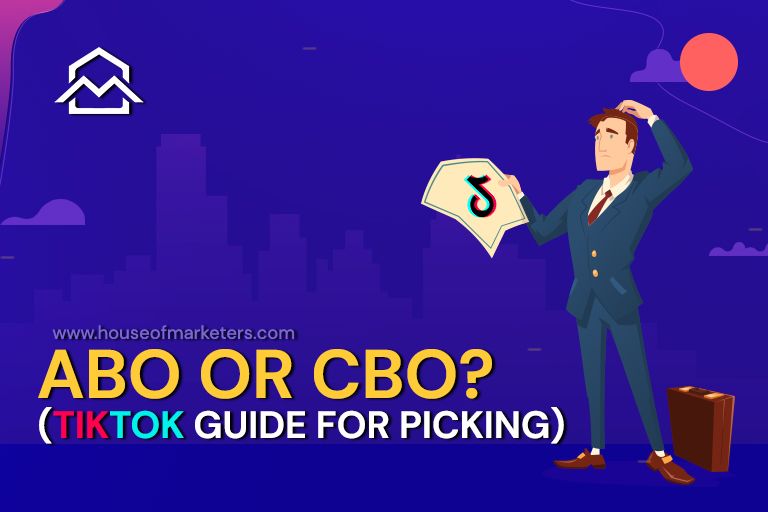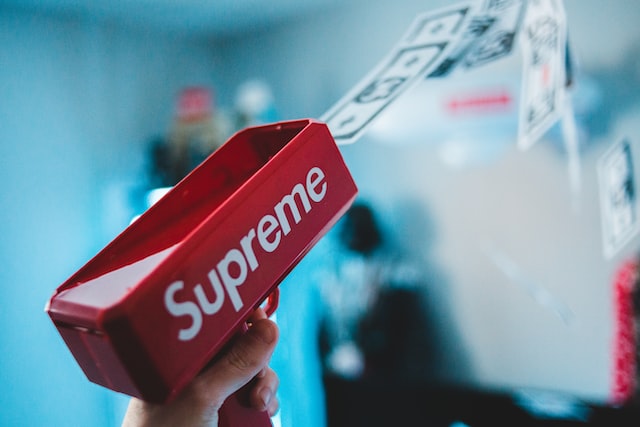Determining whether to use ABO or campaign budget optimization (CBO) on TikTok can be a tricky decision. Both have their pros and cons, and there’s no one-size-fits-all answer for every TikTok campaign. However, each budgeting strategy lends itself to certain types of campaigns and objectives.
This means that TikTok marketers are faced with a choice: ABO or CBO?
This guide by House of Marketers will help you understand the nuances of ABO and CBO, guiding you to make the best decision for your campaign’s goals and stages.

TikTok ads now reach over 17.9% of all internet users over the age of 18. This mind-blowing figure drives home just how important TikTok has become as a marketing platform. Adding to this, TikTok also has a particularly high average engagement rate of 5-16%. This far outperforms all major social platforms such as Facebook, Instagram and YouTube.
ABO and CBO can both be effective ways to capitalize on this high engagement rate and achieve campaign objectives. However, there are some key differences between the two budgeting strategies that marketers should be aware of.
So, for those who are struggling to decide which one is right for their next TikTok ad campaign, we’re put together a guide to make the choice a little clearer.

TikTok ABO vs CBO – What’s the Difference?
Ad Group Budget Optimization (ABO) and Campaign Budget Optimization (CBO) are two different types of budgeting strategies that can be used when running ad campaigns on TikTok.
- CBO (Campaign Budget Optimization) allows you to set an overall campaign budget, which TikTok’s algorithm then automatically allocates across your different ad groups based on performance factors like engagement and conversion rates.
- ABO (Ad Group Budget Optimization) allows you to allocate specific budgets to individual ad groups within your campaign, giving you more control over how much is spent on each group.
What is an ABO Campaign (Ad Group Budget Optimization) on TikTok?
An ABO campaign allows you to take control of how much is being spent at ad group level. It allows you to allocate different amounts of budget to different ad groups within your campaign. The minimum daily budget you can per each and use is $20/£20 per day in ABO campaigns.
When you choose Ad Group Budget Optimization for your TikTok ad campaign, you can allocate a fixed budget to each ad group within your campaign.
For example, if you have a budget of $100 for your entire campaign, you could choose to allocate $50 to Group A and $50 to Group B. Group A might be male sports fanatics aged 18-24, while Group B might be women aged 25-34 with a passion for travelling.
ABO allows you to stay in tight control of your ad spend. It also ensures that each group receives a predetermined portion of your overall budget. As a marketer, you might be thinking that ABO sounds a lot like traditional ad budgeting, and you’d be right. ABO is very similar to the way budgets have been allocated in ad campaigns for years. As a strategy, ABO is well-established and predates the rise of digital marketing.
What is a CBO Campaign (Campaign Budget Optimization) on TikTok?
With Campaign Budget Optimization (CBO), you set an overall budget for your entire campaign. From there, TikTok’s algorithm automatically allocates that budget across your target groups based on a number of factors. This includes engagement rates and conversion rates.
Thereafter, TikTok’s algorithm will determine how the budget should be spent across your different ad groups. With CBO campaigns you have no control over how much budget each ad group is allocated within a campaign. The minimum campaign level daily budget you can use is $50/£50 per day in CBO campaigns.
For example, let’s say you set a budget of $100 for your CBO campaign. TikTok’s algorithm might determine that Group A is more engaged with your ads and more likely to convert, so it might allocate $60 of the budget to Group A and $40 to Group B. The algorithm is constantly learning and optimising in real-time, so the budget allocation can change as your campaign progresses.
In short, with ABO, you have complete control over how your budget is allocated. With CBO, you’re handing over the reins to TikTok’s algorithm and trusting it to make the best decisions for your campaign.
“With CBO, budgeting allocation can vary wildly. For example, let’s say you’re targeting two ad groups – young people under the age of 25, and people over the age of 40. The algorithm may determine that the younger group is more likely to engage with your ads, and allocate over 90% of the budget to that group.”
Let’s take a closer look at ABO and CBO so you can decide which budgeting strategy is right for your next TikTok ad campaign.
“For example, let’s say you set a budget of $100 for your CBO campaign. TikTok’s algorithm might determine that Group A is more engaged with your ads and more likely to convert, so it might allocate $60 of the budget to Group A and $40 to Group B. The algorithm is constantly learning and optimising in real-time, so the budget allocation can change as your campaign progresses.”
To find more about which one is right for your campaign.

ABO vs CBO – Which One Should You Choose?
With more Gen Zers now using TikTok than Instagram, there is a big opportunity for marketers to reach this valuable demographic if they can get their budgeting strategy right.
Deciding between ABO and CBO depends on various factors, including your campaign goals, the maturity of your TikTok ad account, and the specifics of your target audience. For new accounts or highly targeted campaigns, ABO offers more control and precision. For campaigns focused on scale and efficiency, CBO leverages TikTok’s algorithm for optimal budget allocation.
But there are some factors you can consider that might help you make a decision. Let’s break down some of the pros and cons of each strategy:
Ad Group Budget Optimization (ABO)
Pros
- Familiar and well-established budgeting method.
- Complete control over ad spend allocation.
- Ideal for retargeting and segmented audience campaigns.
- Minimum spend as low as $20/£20 per ad group.
Cons
- Time-consuming management for large campaigns.
- Potential to limit campaign potential if not managed carefully.
- Risk of budget misallocation.
Campaign Budget Optimization (CBO)
Pros
- Efficient and time-saving budgeting.
- Optimal for A/B testing with algorithm-driven adjustments.
- Maximizes campaign potential by leveraging TikTok’s algorithm.
Cons
- Requires trust in the algorithm’s decisions.
- Not ideal for highly targeted or low-budget campaigns.
- Unpredictable budget allocation during the learning phase.
Practical Example of ABO and CBO campaign

CBO and ABO both have their advantages and disadvantages. That said, there are some scenarios where you may want to choose one over the other. If you’re trying to test a certain ad group, then ABO would be the preferred budgeting strategy.
For example, let’s say you’re targeting two ad groups: young people under the age of 25, and people over the age of 40.
The algorithm may determine that the younger group is more likely to engage with your ads, and allocate over 90% of the budget to that group. In some cases, this may be the best decision. However, if you’re trying to test the older group to see if they’re a viable target market, you will not be able to do so effectively. ABO would be a better choice in this case, because you can allocate a set budget to each group and see how they perform.
It’s important to note that the minimum spend per day differs between budget types. For CBO campaigns, you must spend £/$/€50 per day. For ABO campaigns you must spend at least £/$/€20 per day per ad group.
- ABO Example: If you have a budget of $100 and two ad groups, you can allocate $50 to each. This way, you can closely monitor and adjust spending based on performance.
- CBO Example: With a $100 budget, TikTok’s algorithm might allocate $70 to a high-performing group and $30 to another. The allocation can change dynamically as the campaign progresses.
How Does the TikTok CBO Algorithm Work?
Before you choose between CBO or ABO, you may want to learn a little more about how TikTok actually determines budget allocation during a CBO campaign. On TikTok, CBO campaigns only require 50 conversions to exit the learning phase, ideally within the first 7 days.
The learning phase refers to the time period when the algorithm is still collecting data and trying to determine which ad groups are performing well. During this phase, you may see some unusual budget allocations as the algorithm tries to figure out which groups are most likely to generate conversions.
That means you can expect your CPA to fluctuate quite a bit as the algorithm optimises. Once the learning phase is over, your CPA should start to stabilise. So don’t panic if it looks like your ad is not performing well initially. Once you get through the testing phase, you can determine whether CBO is actually working for your campaign or not.
Although your campaign performance will stabilise after the learning phase, you may still see some sudden changes in budget allocation. That’s because the algorithm is constantly learning and making adjustments based on new data. So even though your CPA should be more consistent, you may still see some unexpected changes from time to time. Due to the nature of auction ads, it’s not possible to completely predict how the algorithm will behave.
Contact Us

How to Test Ad Groups Using ABO
There are several circumstances where an ABO campaign is more suitable than opting for CBO. If you have a brand new account with no data, ABO is the best way to test ad groups and understand their performance.
Identify Target Audiences:
- Decide which audiences you want to target.
- Create ad groups for each audience.
Allocate Budgets:
Assign a specific budget to each ad group.
Example:
Ad Group 1: Male gamers under 25
Ad Group 2: Female gamers over 30
Daily Budget: $100 ($50 for each ad group)
Monitor Performance:
Run your campaign and monitor the performance of each ad group.
Check metrics like conversions and cost per acquisition (CPA).
Adjust Budget Allocation:
If one ad group performs better (e.g., female gamers over 30 with a lower CPA), reallocate budget from underperforming ad groups (e.g., male gamers under 25) to the better-performing ones.
Pause Ad Group 1 and reallocate its $50 budget to Ad Group 2.
This ensures that your budget is being spent in the most effective way possible.
By following these steps, you can effectively use ABO to test different ad groups and ensure your budget is allocated to the most successful segments, maximising your campaign’s efficiency.

What’s the Verdict?
Nothing is cut and dry in the world of online advertising. The best way to determine whether ABO or CBO is right for your campaign is to test both and see which one performs better.
Keep in mind that your results may vary depending on a number of factors. This includes your campaign goals, target audience, and ad quality. One option that some marketers opt for is to test with ABO and then once they have established which ad groups are performing well, they can scale using CBO. This way, they get the best of both worlds. For starters the ability to fine-tune their budget with ABO and then the scaling potential of CBO.
To know more about how we can collaborate with you for your custom TikTok strategy.
If you need help getting started with your next TikTok campaign, House of Marketers is here to be your guide. We know TikTok inside out and we were founded by one of TikTok’s early employees. This gives us a unique insight into the platform and how to make the most of it.
To learn more about ABO and CBO, or find out which one is right for your campaign, contact us today. One of our expert TikTok marketers will be happy to chat with you and answer any questions you have. Happy advertising!

House of Marketers (HOM) is a leading TikTok Marketing Agency. Our global agency was built by early TikTok Employees & TikTok Partners, which gives us the insider knowledge to help leading brands, like Redbull, Playtika, Badoo, and HelloFresh win on TikTok. Want us to convert more of Gen Z and Millennials with TikTok? Get in touch with our friendly team, here.